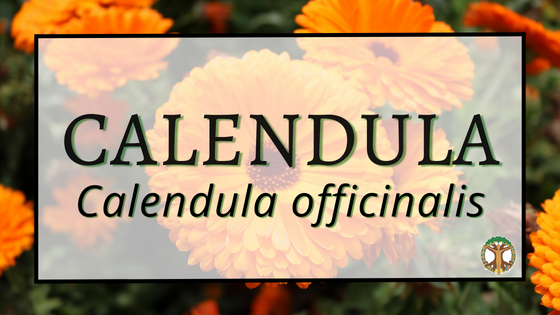
Calendula

Latin name: Calendula officinalis – Asteraceae
Common name: Calendula, pot marigold
Usage: This sticky, golden, aster is well known as an all-star skin remedy. The resinous flowers are cooling and soothing topically, as well as internally. Infused in a carrier oil (olive oil, almond oil, etc), calendula flowers can aid in finding relief from irritated and inflamed skin issues such as: bug bites & stings, dry & cracked skin, eczema, minor burns such as sunburns, scrapes, cuts, and bruises. Both antibacterial and antifungal, calendula makes a wonderful addition to a formula to treat minor topical skin infections in the form of a poultice or compress. Calendula is a common herb used in the treatment of hemorrhoids. A favorite salve formula for bruising and muscle soreness is a combination of arnica flowers (Arnica montana), St. John’s wort flowers (Hypericum perforatum) and calendula flowers. Internally calendula has an affinity for our gastrointestinal and respiratory systems and is cooling to hot, inflammatory issues of both. An infusion of calendula can ease GI irritation related to ulcers, colitis, Chron’s, gastritis, acid reflux, and GERD. The antibacterial properties of calendula also help support this calming action on the GI tract. Calendula infusion is soothing to a sore throat and lungs that are dry and irritated from a cough. Infuse calendula flowers with garden sage leaves (Salvia officinalis) for a gargle to treat a sore throat. Use this same combination as a mouth rinse for oral lesions and infections. Not only is this little flower a medicinal powerhouse, its incredibly beautiful! Sprinkle the golden leaves on your salad for some color. Plant calendula for the pollinators. A common dye plant amongst natural dye makers, calendula offers light yellow to soft brown hues.

Growth/Habitat: Probably native to Southern Europe, calendula has been widely cultivated making its origin a bit complicated discern. A common garden plant, Calendula officinalis is technically short-lived perennial but will not survive the hot summers of Florida or the cold winters of the north. Here in Central Florida, April is probably the last month that you will be gathering calendula blossoms as we phase into the long, hot summer days and the plant dies back. Plant seeds in autumn and winter for a spring harvest. Calendula prefers a sunny location with rich, well-drained soil. Flowering quickly from seed, calendula will continue to flower prolifically if dead-headed.

Recipe: Calendula oil
Ingredients: calendula flowers, carrier oil, jar, cheesecloth
- Lightly pack a jar with freshly wilted or dry calendula flowers
- Cover flowers with oil so there is about one inch of oil covering the plant matter
- Make note of how this smells and check your oil frequently for any signs of spoilage or mold
- Label and let sit in a temperature consistent space for a minimum of two weeks
- Strain with cheesecloth, bottle, and label
- Use as is or in your favorite salve blend






